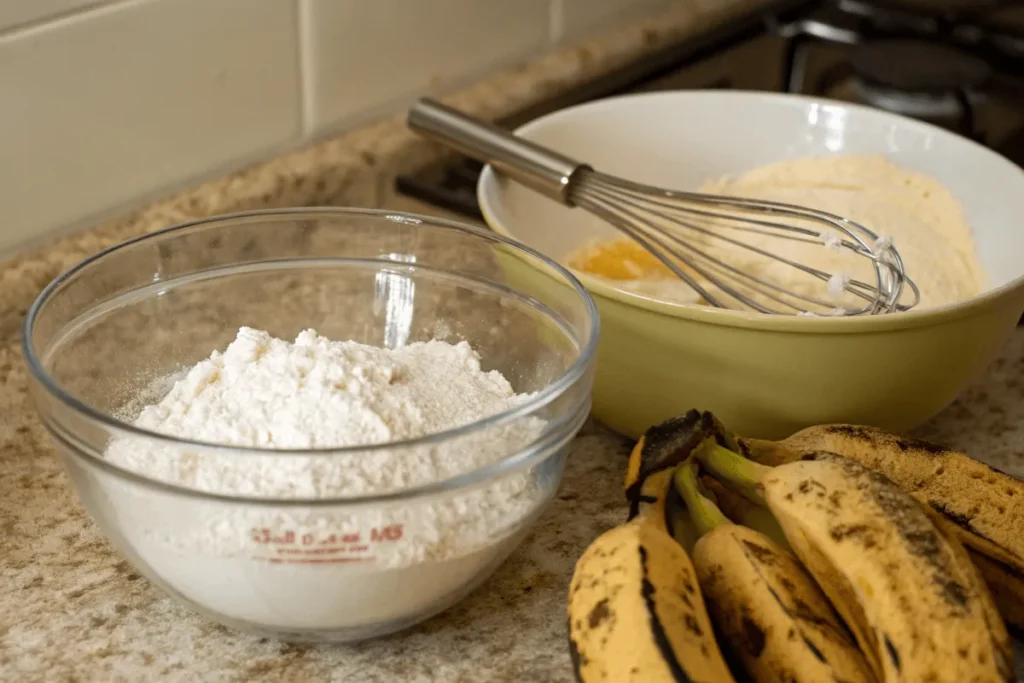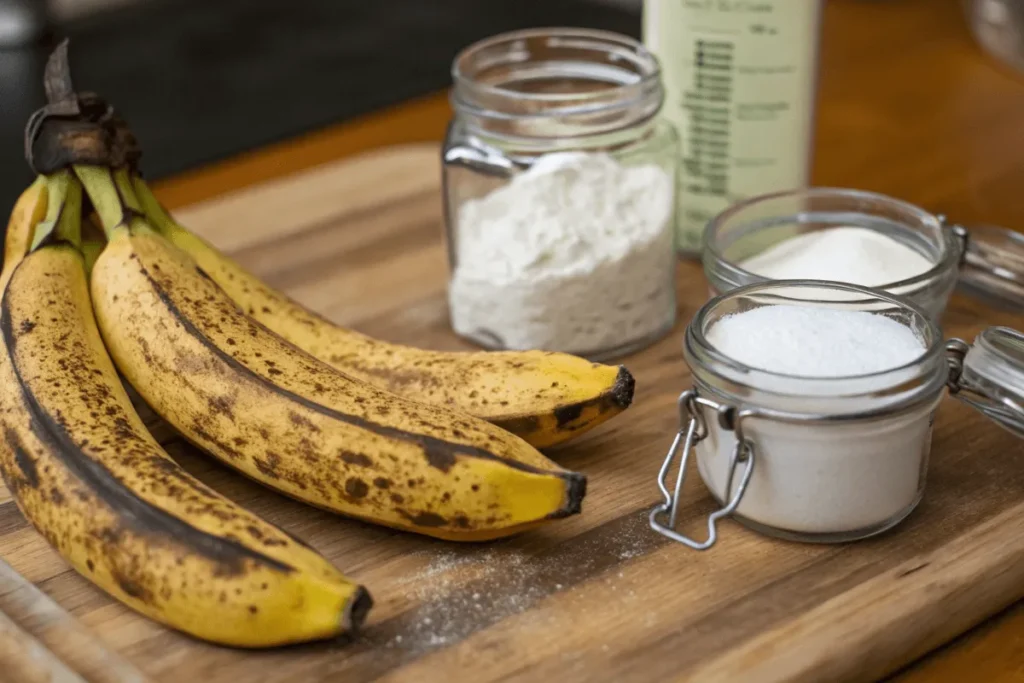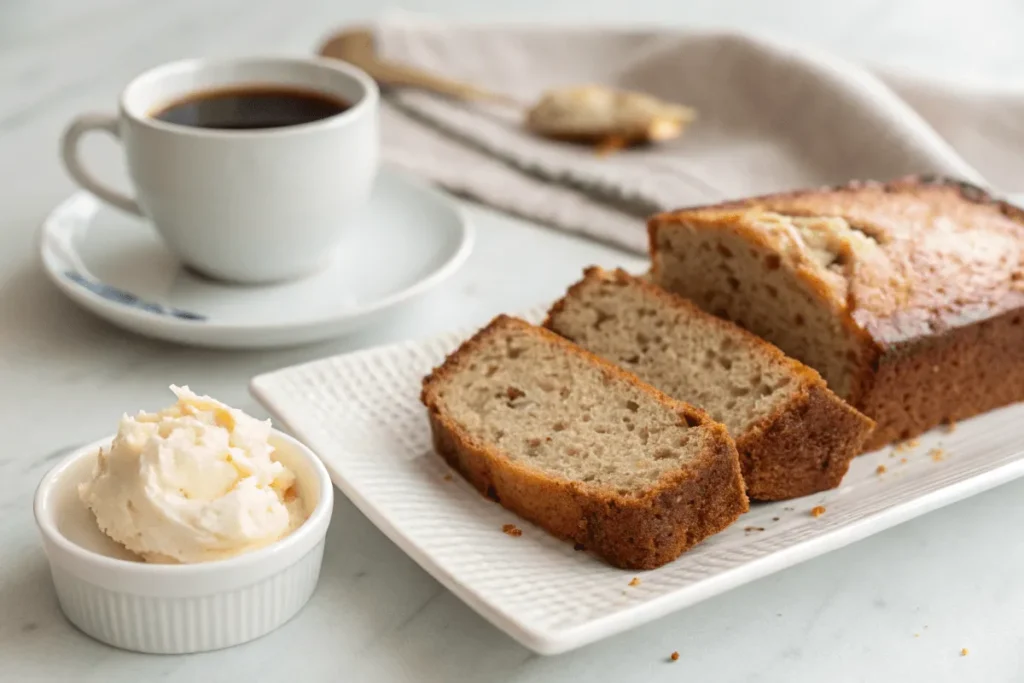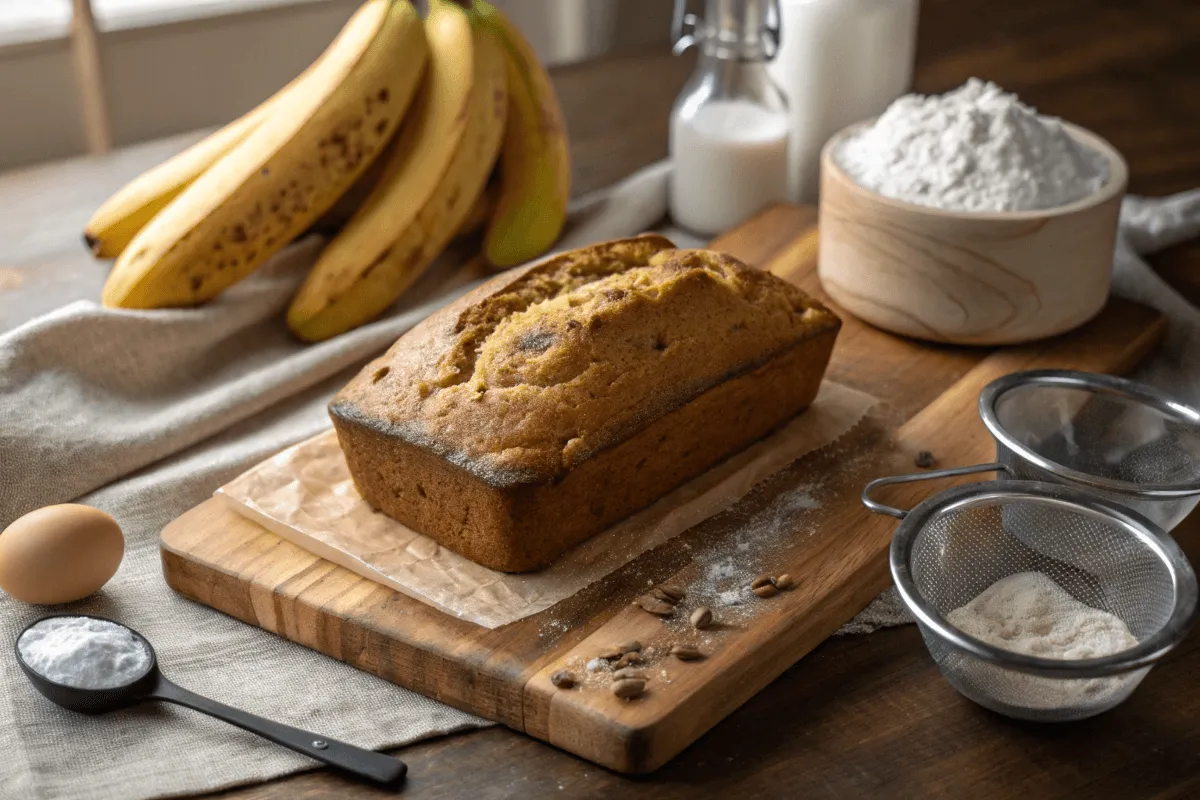When it comes to making the perfect banana bread, there’s a common question that comes up: Should I use baking soda or baking powder for banana bread? This seemingly simple question holds the key to creating the perfect loaf. Both baking soda and baking powder are essential leavening agents in baking, but they serve different purposes and can drastically affect the texture and flavor of your banana bread. In this article, we’ll explore when and why you should choose one over the other, and how the two ingredients work together to create that soft, fluffy, and flavorful banana bread we all love.
Table of Contents
Part 1: Introduction to Leavening Agents in Baking
Before diving into the specifics of baking soda and baking powder, it’s essential to understand what leavening agents do in baking. Leavening agents are ingredients that help baked goods rise by producing gas, usually in the form of carbon dioxide. This gas gets trapped in the batter or dough, causing it to expand and create air pockets, which leads to the light, fluffy texture we desire in baked goods like banana bread.
What Are Leavening Agents?
Leavening agents come in two main types: chemical and biological. Baking soda and baking powder are chemical leavening agents, meaning they work through a chemical reaction to create the gas necessary for leavening. Yeast is an example of a biological leavening agent, but it’s not used in banana bread. When we talk about banana bread, we’re primarily concerned with baking soda and baking powder.
Why Leavening Agents Matter in Banana Bread
Banana bread is typically dense and moist due to the mashed bananas in the batter. However, without the right amount of leavening agent, it could turn out too heavy or flat. That’s where baking soda or baking powder plays a crucial role. By adding the right amount, you ensure that your banana bread rises beautifully, giving you that tender, soft crumb that is moist yet airy. So, let’s dive into understanding how these leavening agents work specifically for banana bread.
Part 2: The Role of Baking Soda in Banana Bread
When making banana bread, one of the most commonly used leavening agents is baking soda. But how exactly does baking soda work in banana bread, and why is it often the preferred choice? Let’s dive into the role of baking soda and explore its benefits for your banana bread.
How Does Baking Soda Work in Banana Bread?
Baking soda, scientifically known as sodium bicarbonate, is a chemical leavening agent that needs an acid to activate it. In banana bread, the acidic element typically comes from the ripe bananas themselves, which are naturally slightly acidic. Once combined with baking soda, the acid in the bananas triggers a chemical reaction that produces carbon dioxide gas. This gas creates bubbles in the batter, which helps the bread rise and become light and airy.
This reaction doesn’t stop once the bread hits the oven—it continues to produce gas, which is why banana bread made with baking soda tends to rise beautifully and have a soft, moist texture. Without the carbon dioxide produced by the reaction, the banana bread would turn out denser and less fluffy.
Why Baking Soda is the Preferred Leavening Agent for Banana Bread
Many bakers swear by baking soda for banana bread because it not only helps the bread rise but also contributes to the flavor. The alkalinity of baking soda works in tandem with the bananas’ natural acidity, which helps balance the sweetness and provides a slight, pleasant tang. Without baking soda, your banana bread could taste too one-dimensional or overly sweet.
In addition, baking soda also promotes the caramelization of sugars in the batter, resulting in that rich, golden-brown crust that so many banana bread lovers adore. It creates a perfect contrast to the soft, moist interior. That being said, the key to getting the best rise and flavor lies in using the right amount of baking soda—too much, and your bread could taste metallic; too little, and it might not rise properly.
Part 3: The Role of Baking Powder in Banana Bread
While baking soda is often the go-to leavening agent for banana bread, there are instances when baking powder is used instead, or even in combination with baking soda. Understanding how baking powder works in banana bread can help you determine when it’s the right choice for your recipe.
How Does Baking Powder Work in Banana Bread?
Unlike baking soda, which needs an acid to activate it, baking powder contains both an acid (usually cream of tartar) and a base (usually baking soda). This means that baking powder only needs moisture and heat to activate the leavening process. When mixed into the banana bread batter, the baking powder produces carbon dioxide gas in two stages: once when mixed with the wet ingredients, and again when heated in the oven. This results in a gradual rise that can help create a light, fluffy texture in your banana bread.
When to Use Baking Powder in Banana Bread Recipes
So, Should I use baking soda or baking powder for banana bread? The answer depends on the recipe. If the recipe calls for both baking soda and baking powder, it’s likely because it needs a balanced rise with a slightly different texture. Some banana bread recipes may call for baking powder to give the bread a lighter, airier structure, particularly if you’re using non-acidic ingredients or want to control the density of the loaf.
For example, baking powder can be an excellent choice if your banana bread batter feels a bit too dense or if you’re using ingredients that don’t provide enough acidity to activate baking soda. However, if you’re making a simple, traditional banana bread where the bananas themselves are ripe and slightly acidic, baking soda is often the best choice to get that perfect rise
For additional baking tips, check out What is the Secret to Super Moist Cake?.

Part 4: Baking Soda vs. Baking Powder: Which One Should You Use for Banana Bread?
When it comes to choosing between baking soda and baking powder for banana bread, it’s important to understand the role each one plays. While both leavening agents are essential for helping your bread rise, they work in different ways, and the choice depends on several factors. So, should I use baking soda or baking powder for banana bread? Let’s break it down.
Understanding the Differences Between Baking Soda and Baking Powder
The primary difference between baking soda and baking powder lies in their ingredients and how they react in your recipe. Baking soda is pure sodium bicarbonate, which requires an acidic ingredient to activate it, such as the ripe bananas in banana bread. On the other hand, baking powder contains both an acid (usually cream of tartar) and a base (baking soda), meaning it only requires moisture and heat to start its leavening action.
In banana bread, the ripe bananas naturally provide enough acidity to activate baking soda, making it the more common leavening agent used in recipes. However, if your recipe lacks an acidic component or calls for an extra rise, baking powder may be added alongside or in place of baking soda.
Which Is Better for Banana Bread?
So, should I use baking soda or baking powder for banana bread? The answer largely depends on your recipe. If your bananas are ripe and the recipe doesn’t contain other acidic ingredients, baking soda will typically do the trick. The bananas themselves provide the acid that activates baking soda, helping your banana bread rise perfectly. Baking soda also helps create that delicious golden-brown color and contributes to a moist texture.
However, if you want an extra light and fluffy texture or if your recipe includes ingredients like buttermilk or yogurt (which are more acidic), you might prefer baking powder. Some recipes even use both to achieve the ideal rise, combining the strengths of each leavening agent. Ultimately, the choice between baking soda and baking powder depends on the balance of acids in your batter and the texture you’re aiming for in your banana bread.
For more inspiration, explore What Does Adding Brown Sugar to BBQ Sauce Do?.

Part 5: Common Mistakes When Using Baking Soda and Baking Powder in Banana Bread
While baking soda and baking powder are essential to making perfect banana bread, there are some common mistakes that can affect your results. From using too much of one ingredient to choosing the wrong one, understanding these pitfalls will help you avoid mishaps in your baking.
The Dangers of Using Too Much Baking Soda
One of the most common mistakes when making banana bread is using too much baking soda. While baking soda helps your banana bread rise and adds flavor, too much of it can lead to an unpleasant, metallic taste. This is especially true in banana bread, where the bananas are already slightly acidic, which naturally activates the baking soda. When using baking soda alternatives, such as baking powder substitutes, it’s crucial to balance the amount in your recipe to avoid over-leavening your batter.
Using the right amount of baking soda ensures your banana bread rises properly and has the right texture. For most banana bread recipes, typically, one teaspoon of baking soda per two to three ripe bananas is the ideal ratio. If you use too much baking soda, you could compromise the flavor and texture, leading to a dense loaf that might have a bitter aftertaste.
Choosing the Wrong Leavening Agent
Another mistake is choosing the wrong leavening agents for banana bread. Baking soda and baking powder are different leavening agents, and they work best in different situations. Baking soda works well in banana bread because it needs an acidic ingredient (like ripe bananas) to activate it. If you use baking powder instead of baking soda, your banana bread may rise too much and then collapse, leading to a dry or crumbly texture.
If your recipe calls for baking soda, but you use baking powder substitutes, the texture could become lighter than intended, and you might lose the rich, dense texture that banana bread is known for. Conversely, if your recipe calls for baking powder but you use baking soda, it might not rise properly without an acidic ingredient to activate the baking soda.
Over-Leavening Your Banana Bread
Over-leavening is a common problem when using both baking soda and baking powder together. While these two leavening agents can work in tandem in certain recipes, too much quick bread leavening can cause the batter to rise too quickly and then collapse. This results in an uneven texture or a bread that’s too airy and crumbly.
To avoid over-leavening, always check your recipe and use the right balance of baking soda and baking powder for banana bread. If you’re unsure, it’s better to use just one leavening agent—usually baking soda for banana bread—unless the recipe specifically calls for both.
For more insights on ingredient substitutions, explore How to Substitute Ingredients Like a Pro.
Part 6: Frequently Asked Questions (FAQs)
In this section, we will address some of the most frequently asked questions regarding baking soda and baking powder in banana bread. These questions can help clear up any confusion and guide you in making the best choice for your baking needs.
Should I use baking soda or baking powder in banana bread?
If you’re wondering, Should I use baking soda or baking powder for banana bread? the answer depends on the ingredients in your recipe. Generally, baking soda is the best option for banana bread, especially if your bananas are ripe. The natural acidity in the bananas activates the baking soda, helping your banana bread rise perfectly. However, if you’re using other acidic ingredients, like buttermilk or yogurt, you might want to consider using baking powder as well.
For most banana bread recipes, baking soda is the ideal leavening agent for banana bread, as it provides a moist, dense texture with a rich flavor. If you prefer a lighter, fluffier loaf, using a combination of baking soda and baking powder substitutes can give you that result. So, the key is balancing the acidity in the batter and the quick bread leavening agents to match your desired texture and flavor.
Which is better for bread, baking soda or baking powder?
When deciding between baking soda or baking powder for bread, it often comes down to the type of bread you’re making. Baking soda is typically better for quick breads like banana bread, where the batter relies on an acidic ingredient, like ripe bananas, to activate it. On the other hand, baking powder is more commonly used in recipes where no natural acid is present, as it already contains an acidic component.
For banana bread specifically, baking soda works best since the bananas provide the necessary acid to activate it. If you’re making a bread that doesn’t have an acidic component, like some types of yeast bread, baking powder substitutes might be a better choice.
Is baking soda or baking powder better for self-raising flour?
If you’re using self-raising flour, there’s no need to worry too much about baking powder or baking soda. Self-raising flour already contains baking powder, so you don’t need to add any extra. However, if your recipe calls for baking soda in addition to self-raising flour, you’ll still need to add that to balance the acid in the recipe.
In banana bread, if you’re using self-raising flour, you can often skip adding baking powder or baking soda because the flour already provides the necessary leavening. Just be sure to follow your recipe’s specific instructions to avoid over-leavening or under-leavening your bread.
Will too much baking soda ruin banana bread?
Yes, using too much baking soda in banana bread can indeed ruin the taste and texture. Baking soda helps the bread rise and provides a slightly tangy flavor that complements the bananas. However, if you use too much, it can give the bread a bitter or metallic taste. To avoid this, it’s important to follow the recommended measurements in your recipe. For most banana bread recipes, using around 1 teaspoon of baking soda per 2 to 3 bananas is the ideal amount. Using the right baking soda alternatives in place of excess baking soda can help ensure the proper texture and flavor.
For tips on avoiding common baking errors, visit Top 10 Baking Mistakes and How to Fix Them.
Part 7: Tips for Perfect Banana Bread Every Time
To wrap up our exploration of baking soda vs. baking powder in banana bread, let’s focus on some practical tips to help you achieve the perfect loaf every time. Whether you’re asking Should I use baking soda or baking powder for banana bread?, or simply want the best results, these tips will ensure your banana bread turns out delicious and perfectly textured.
Use Ripe Bananas for Maximum Flavor
The key to delicious banana bread starts with ripe bananas. The baking soda works best when the bananas are fully ripe, providing enough acidity to activate the leavening agent. Overripe bananas are ideal for banana bread because they add natural sweetness and a rich flavor. So, let your bananas brown a little before using them—they’ll not only activate the baking soda, but also give your banana bread the perfect texture and taste.
Measure Your Leavening Agents Correctly
When deciding Should I use baking soda or baking powder for banana bread?, it’s crucial to measure accurately. Too much baking soda can result in a bitter, metallic taste, while too little can leave your bread dense and flat. Typically, one teaspoon of baking soda for every two to three ripe bananas is ideal. If you’re using baking powder, make sure to follow your recipe’s measurements closely to avoid over-leavening, which could affect the texture of your bread.
Mix Gently, Don’t Overmix
Overmixing your batter is one of the most common mistakes when making banana bread. If you overmix, the bread can turn out tough instead of light and airy. When adding the dry ingredients to the wet ingredients, mix just until combined. This gentle mixing helps preserve the air pockets created by the baking soda or baking powder, resulting in a moist, tender loaf.
Bake at the Right Temperature
Banana bread can be tricky to bake at just the right temperature. Preheat your oven to the recommended temperature, usually around 350°F (175°C). Baking at a temperature that’s too high can cause the outside of your banana bread to brown too quickly, while the inside remains raw. For the best texture and rise, bake at the recommended temperature and use an oven thermometer to ensure accuracy.
Let It Cool
Allow your banana bread to cool completely before slicing. This step is important because it helps set the texture and allows the flavors to develop fully. Cutting into it too soon may cause it to fall apart or become too gooey. Give it time to cool, and you’ll have perfectly textured banana bread.

Part 8: Conclusion and Final Tips for Banana Bread
In conclusion, when making banana bread, understanding the role of leavening agents like baking soda and baking powder is essential for achieving the perfect rise and texture. So, Should I use baking soda or baking powder for banana bread? The general rule is that baking soda is your best bet, especially if you’re using ripe bananas. The natural acidity in ripe bananas activates baking soda, helping your banana bread rise perfectly. However, some recipes may call for both baking soda and baking powder, depending on the desired texture and flavor. Let’s dive deeper into how these two leavening agents affect the outcome of your banana bread.
Key Takeaways on Leavening Agents
To recap, baking soda works best for banana bread because it reacts with the acid in the bananas, allowing your bread to rise and become light and airy. Baking powder may also be used in combination with baking soda to achieve a lighter texture, particularly when the recipe includes additional acidic ingredients like buttermilk or yogurt. However, when asking Should I use baking soda or baking powder for banana bread?, it’s important to consider the specific recipe and your desired outcome. Always make sure to follow your recipe’s instructions carefully to get the ideal balance of leavening agents.
Final Tips for Perfect Banana Bread
When baking banana bread, the right measurements are crucial, especially when using baking soda or baking powder. Too much of either agent can negatively impact the flavor and texture, leaving your banana bread with an unpleasant taste or an uneven rise. Be sure to use the right amount of baking soda (typically about 1 teaspoon per 2-3 ripe bananas) to avoid bitterness. Additionally, ensure that your bananas are ripe enough to activate the baking soda—overripe bananas are perfect for this! Finally, enjoy the process of baking your banana bread, whether you use baking soda, baking powder, or both. With the right balance of ingredients, you’ll bake a delicious, moist, and fragrant banana bread that’s sure to impress!
For more tips on troubleshooting baking mishaps, check out Top Fast Recipes’ Baking Guide.


1 thought on “Should I Use Baking Soda or Baking Powder for Banana Bread?”